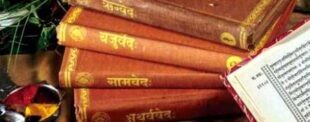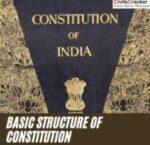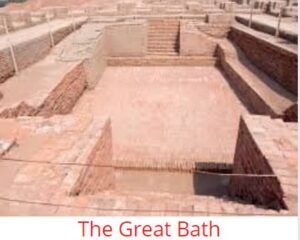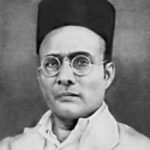Home » Archives for Anand » Page 13
Indian Polity MCQs – 3 (Salient Features Of The Indian Constitution)
Salient features of the Indian Constitution MCQs with answers and explanations for preparation of UPSC, BPSC, UPPSC and other State PSC Examinations
1. Eighth Schedule recognizes which of the following languages?
- English
- Sanskrit
- Kashmiri
- Hindi
Select the correct answer using the codes below :
a) 3 and 4 only
b) 1 and 2 only
c) 2, 3 and 4 only
d) 1, 2, 3 and 4
Correct Answer : (c) 2, 3 and 4 only
- Originally, the 8th schedule had 14 languages; however, after multiple amendments, presently there are 22 languages.
- They Are :
- Assamese
- Bengali
- Bodo
- Dogri (Dongri)
- Gujarati
- Hindi
- Kannada
- Kashmiri
- Konkani
- Mathili (Maithili)
- Malayalam
- Manipuri
- Marathi
- Nepali
- Oriya
- Punjabi
- Sanskrit
- Santhali
- Sindhi
- Tamil
- Telugu
- Urdu
- English is not recognized under 8th schedule, however, it is the official language of India.
2. Which of the following is not a feature of the Indian Constitution ?
(a) Written constitution
(b) Federalism
(c) Sovereignty of Parliament
(d) Judicial Review
Correct Answer : (c) Sovereignty of Parliament
- The Constitution of India has opted for the British Parliamentary System of Government rather than the American Presidential System of Government.
- Even though the Indian parliamentary system is largely based on the British pattern, there are some fundamental differences between the two. For example, the Indian Parliament is not a sovereign body like the British Parliament. Further, the Indian State has an elected head (republic) while the British State has hereditary head (monarchy).
- Hence, Sovereignty of Parliament is not a feature of the Indian constitution.
3. Indian Constitution is :
(a) Federal
(b) Unitary
(c) Quasi-federal
(d) Presidential
Correct Answer : (a) Federal
- The Indian Constitution has been variously described as ‘federal in form but, unitary in spirit’ or ‘quasi-federal’ in nature.
- It contains all the usual features of a federation, for example:
- Two levels of governments,
- Division of powers,
- Written Constitution,
- Supremacy of Constitution,
- Rigidity of Constitution,
- Independent judiciary
- Bicameralism.
- However, the Indian Constitution also contains a large number of unitary or non-federal features, for example:
- A strong Centre,
- Single Constitution,
- Single citizenship,
- Single integrated judiciary,
- Appointment of state governor by the Centre,
- All-India services,
- Emergency provisions
4. Which one of the following is not a part of the ‘basic structure’ of the Indian Constitution ?
(a) Rule of law
(b) Secularism
(c) Right to Property
(d) Parliamentary form of government
Correct Answer : (c) Right to Property
- Right to Property is not a part of the basic structure of the constitution. Right to Property is just a legal right.
- The right to property ceased to be a fundamental right by the 44th Constitution Amendment Act, 1978. However, it continues to be a legal right under Article 300 A of the Constitution.
- Rule of law, Secularism, Parliamentary form of government are part of the basic structure of the constitution.
5. Indian Constitution is
(a) Rigid
(b) Flexible
(c) Neither rigid nor flexible
(d) Partly rigid and partly flexible
Correct Answer : (c) Neither rigid nor flexible
- Constitutions are also classified into rigid and flexible.
- A rigid Constitution is one that requires a special procedure for its amendment, as for example, the American Constitution.
- A flexible constitution, on the other hand, is one that can be amended in the same manner as the ordinary laws are made, as for example, the British Constitution.
- The Constitution of India is neither rigid nor flexible, but a synthesis of both.
6. Which of the following statements about the Constitution of India is/are correct?
- Popular sovereignty and adult franchise are the basic features of the Constitution.
- The Constitution, in so far as the division of powers between the Centre and the States is concerned, is rigid.
- The Constitution mentions direct control by the people such as referendum, initiative and recall.
Select the correct answer from the codes given below:
(a) Only 1
(b) 1 and 2
(c) 2 and 3
(d) None of the above
Correct Answer : (b) 1 and 2
- It is true that popular sovereignty and adult franchise are the basic features of the Constitution.
- In the matter of division of powers between the Centre and the States, the Indian constitution can be considered as rigid as the division of power has been explicitly written in the constitution itself and it does not depend on the whims of the Parliament.
- The constitution doesn’t mention direct control by the people such as referendums, initiative and recall. These are the instruments of direct democracy which is practiced in Switzerland.
- The Indian constitution provides for an Indirect democracy.
7. Consider the following statements:
The salient features of the Indian Constitution provide for:
- Single citizenship for the whole of India.
- Strictly federal form of government.
- Unique blend of rigidity and flexibility.
Among the above statements:
(a) 1, 2 and 3 are correct
(b) 1 and 2 are correct
(c) 2 and 3 are correct
(d)1 and 3 are correct
Correct Answer : (d) 1 and 3 are correct
- The constitution of India establishes a Quasi-Federal system of Government which is a blend of rigidity and flexibility.
- The constitution of India provides for single citizenship for the whole of India.
8. In the Constitution of India, the term ‘Federal’ appears in :
(a) The Preamble
(b) Part III of the Constitution
(c) Article 368
(d) None of the above
Correct Answer : (d) None of the above
- In the Constitution of India, the term ‘Federal’ appears in the part I of the Constitution.
- The Preamble does not mention the word ‘Federal’.
- Part III of the constitution deals with Fundamental rights (Article 12 – 35).
- Article 368 provided for provision of amendments of the constitution.
9. Which of the following features of the Indian Government system are the essential features of the parliamentary Government system?
- Presence of nominal and real executives
- Membership of the ministers in the legislature(Parliament)
- Separation of powers between the Union and States
- Independent judicial system
Select the correct answer using the codes given below:
(a) 1 and 2 only
(b) 1, 2 and 3 only
(c) 2 and 3 only
(d) 1, 2, 3 and 4
Correct Answer : (a)
- ‘Presence of nominal and real executives’ and ‘Membership of the ministers in the legislature’ are the salient features of the Parliamentary Government system.
- Separation of powers between the Union and state government may exist under the presidential government system also as it is found in the United states of America.
- Independent judiciary system can exist in both Parliamentary and Presidential systems.
10. Which of the following federal principles are not found in the Indian federation ?
- Bifurcation of the judiciary between the Federal and State Governments
- Equality of representation of the states in the upper house of the Federal Legislature
- The Union cannot be destroyed by any state seceding from the Union at its own will
- Federal Government can divide the existing states or even redraw the map of the Indian Union by forming new States
Select the correct answer using the codes given below :
(a) 1, 2 and 3
(b) 2, 3 and 4
(c) 1 and 2
(d) 3 and 4
Correct Answer : (c)
- The Indian constitution does not provide for bifurcation of the judiciary between the Union and State Governments. Rather, the Indian constitution provides for a single integrated Judiciary.
- The Indian constitution does not provide for Equality of representation of the states in the upper house of the Federal Legislature. Instead, it provides for proportional representation in the upper house(Rajya Sabha).
- Any state can not secede from the Indian Union at its own will.
- The Union Government can divide the existing states or even redraw the map of the Indian Union by forming new States or merging the existing states.
More questions are coming soon. Join us on Whatsapp for latest updates: Join CivilsCracker on Whatsapp


















